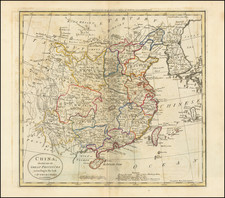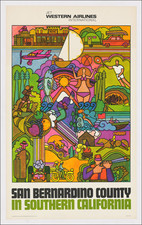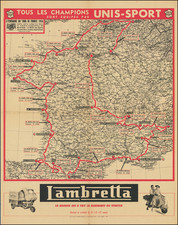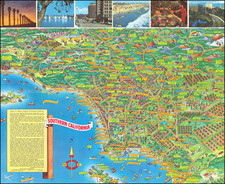A Beijing Pictorial Rarity – The Welfare Map
Whimsically-designed and colored example of an extremely rare pictorial map of China, made by an American missionary woman born in Tianjin.
The map takes the viewer on a cartoonish tour of Beijing, or Peiping as it was sometimes called. Crenelated walls surround the city, with three-tiered gates allowing entrances and exits. A select number of streets are drawn in for orientation, as are major sites of interest including the Forbidden City, the Winter Palace, the Tower of Agriculture, the Temple of Heaven, and various other sites such as the Polo Field and Gold Fish Pools. Tucked into the walls of the city on the right side is the Observatory, complete with a globe and an armillary sphere.
An examination of the other buildings reveals the particular position of the author, which is that of an American Protestant missionary. The various churches, missions, and philanthropic ventures of the Protestants denominations are all shown in detail. The latter include many schools and universities, a maternity clinic, a bible school, a health station, and the Salvation Army which are scattered around the central Forbidden City. Interestingly, there is practically no Catholic presence marked on the map, even though Catholics were active in several sites in the city. There is the Roman Catholic Pei Tang Cathedral in the northern section of the map, as well as a Russian Orthodox Church, in addition to the plethora of Protestant churches and projects.
Outside the walls, signs point to other attractions and important places, including the Summer Palace, sanitariums, and the Hill-Murray School for the Blind. A stout bus with a smiling child heads away from the city, narrowly missing a boar. This is labeled Yenching Bus and refers to Yenching University, where the author taught.
The map primarily underlines the Christian “welfare” institutions at work in Beijing in the mid-1930s. Ancillary to this goal are the many caricatures that populate the map. There is a persimmon seller, a man pushing a Salvation Army cart with rice for the rickshaw men, a blacksmith shoeing a donkey (safely), a street sprinkler, an elderly man with a bird in a cage, a barber at work, and many others. These vignettes provide a slice of life as observed by the author and show a happy, bustling Beijing.
Marguerite Atterbury
The maker signs their name in the bottom left corner with a smiling face tucked into the “A.” "Atterbury" most likely refers to Marguerite Atterbury. Marguerite was the daughter of Boudinot Currie Atterbury (1852–1930), a Phillips Academy and Yale educated medical doctor who worked with the Presbyterian missions in China from 1879 to 1898 and later worked with Chinese communities in Pasadena, Los Angeles and Brooklyn.
His daughter Daisy (Marguerite) was born in Tianjin in 1898 and attended Wellesley (class of 1918) and Columbia. She then returned to China to teach at Yenching University and pursue missionary work. During WWII, she was interned in the Japanese Weihsien Compound (repatriated 1943). The depiction of the Yenching bus at the top left is a compelling clue, as are the observations in the Chinese language article written about this map (see translation below).
We located the following on a Chinese language website discussing pictorial maps of Beijing. While the work is remarkably detailed, the writer was not able to identify the maker due to its stylistic font. He identifies her as "HER WVY" instead, as noted below. The following is a Google translation of large portions of the article.
The discovery of maps (2): The motivation of a map-analysis of another old map reflecting the old Beijing style 80 years ago (multiple maps)
Published on June 20, 2009 Edited by CND "Huaxia Digest"
... Because I have been following the "A Map and History of Peiping" drawn by Dorn in 1936 (see my blog "This Map of Beijing and that American General"), Mr. Li Biao of Pan Jiayuan and I sent a newly discovered old map to me.
It is a very interesting old map that has not been disclosed by the collectors before. Incidentally, the "old" map is of course before the Qing Dynasty, but except for the late Qing Dynasty, we rarely collect it, and some are not maps in the sense of modern surveying and mapping. In terms of collection, I considered "old" in the early Republic of China and before the 1940s. I used "60 years ago, modern surveying and mapping, rare folk, rich in information" as the collection standard of "old pictures".
This picture is 56 cm high and 42 cm wide. It is printed in monochrome, English, and printed on Dowling paper. In the lower left corner, there is a marker related to the drawer and the "HER BVY" department, but I have only guessed so far, and I cannot interpret it.
At a glance, the biggest feature of this picture is its comic style. Compared with the color smudged landscape of Mr. Dorn, this picture reminds me of Erge's "tintin". I often sigh the deep preparation of Western culture and active thinking. For example, "HER WVY" and Dorn ’s map drawing, they can actually apply the art method to the map. In the east, China ’s old maps have traces of traditional landscape paintings, and Japan has also made a lot of bird’s-eye maps. The main category is to focus on the overall location, and not pay much attention to the traces of specific human activities on the ground. It is also a reflection of the difference in the way of thinking in the map.
If you take a closer look at this map, it is accurate in the overall layout of Beijing City. Important landmarks such as the city wall, city gate, Forbidden City, central axis, East Fourth, West Fourth, West Single Arch, Temple of Heaven, Xiannong Temple, Qianmen Railway Station, etc. There are some important cultural highlights in the city, and now the "National Library" on Wenjin Street, the Lama Temple and the observatory on the east wall of the city are also marked with pictures and text. Outside the city wall, it specifically noted that there are shuttle buses to Tsinghua University, Summer Palace and Xiangshan Ci kindergarten outside Xizhimen, and Fuchengmen to the "Blind School". In addition, Dongzhimen picks up farmers from the city, Chaoyangmen. The "Beijing Uncle" who raised the caged bird, there are transportation camels outside the Yongding Gate in the south of the city, there are young people riding bicycles outside the Fucheng Gate in the west of the city, and there are hawkers selling carts outside the Youanmen. "Cai Shikou" entered the city from here.
The most interesting thing in this picture is the characters that reflect the folk life of old Beijing. Persimmons, sawn wood, horseshoes, shuttlecocks, kites, shaved heads, soya-bean milk drinkers, shopping on rickshaws, street sprinklers, donkey riders, donkey riders into the city, singing There was also a gust of wind blowing behind the tinkling car that blew the hat off. I am not only interested in maps composed of comics, but also the unique eyes of the map drawer, who recorded these details. History and culture are made up of countless such fragments. Without these details, at least the folk history of Beijing has become some big and unreasonable empty words.
Such interesting details as the wind blowing off the hat, I really appreciate the humor that the author still has when drawing maps! Humor is a symbol of wisdom, but the humor shown in the map, "HER WVY" is a rare example. You see: He painted the horseshoe, the donkey's attitude, and the explanation "Please pay attention to safety-horseshoe", and the expression of the child playing the shuttlecock and flying the kite, which makes you think of Zhang Leping and Erge.
Another important value of this picture is that it records the distribution of Beijing church culture 80 years ago.
. . . Catholicism entered China from the Tang Dynasty, and early in the Qing Dynasty, Jesuit Ricci and others entered the Taichi. While bringing Western technology and culture, it also accelerated its missionary work in China. In 1642, Emperor Kangxi officially declared [acceptance of missionaries]. After 30 years, Yongzheng withdrew the edict and officially regarded Christianity as a heresy for the next 120 years. In 1773, the Pope ordered the dissolution of the most influential Jesuits in support of Christian missionary activities, which also had a great impact on Matteo Ricci ’s missionary activities in China. In the middle of the 19th century, Catholic missionary activities in Europe flourished again. By 1840, Catholicism, especially Protestant missionary activities in China had been launched. In the development of modern Chinese history, folk acceptance and resistance to the entry of Western religions is a major clue, highlighted by the Taiping Heavenly Kingdom and the Boxer Rebellion.
The thirteenth paragraph of the Sino-French Tianjin Treaty approved in 1860 stipulates that Catholics are guaranteed free preaching and religious activities throughout the Qing Empire, and that the Chinese are entitled to Christian activities without punishment. This agreement provided a prerequisite for the unprecedented development of missionary activities. According to The History of Cambridge in the Late Qing Dynasty edited by Fei Zhengqing, by 1900, there were 886 Catholic priests from Europe in China, and there were 500 Protestant preaching stations (operated directly by foreign missionaries), with sub-stations (served by the Chinese) in the thousands. In 1905, there were 3,445 Protestant missionaries in China, of which more than 90% were British and American. I noticed the details provided by Fei Zhengqing: "British Protestant missionaries generally come from the middle class and a few people have gone to college. American Protestant missionaries are generally from the backcountry of small cities, usually college graduates of a certain denomination." These are the origins of Stilwell, Dorn, Stuart and others.
Back to this map. I believe that the word "WELFARE" here has the meaning of "charity" and "welfare" related to the Chinese "welfare". In China, the activities of Western missionaries mainly revolve around medical care, education, and charity such as opening an orphanage. "The activities of the Protestants gradually have a more fixed nature. They are usually built in the preaching stations in the city. The typical pattern is to have a sermon hall or street chapel, a church building, one or several schools, the residence occupied by priests and their Chinese helpers, a clinic, and sometimes a small hospital. This evangelistic station forms a core unit of the city. This is because "For a foreign religion to make progress in any society, it must adapt to the needs of the members of that society.” ”The answer to them depends on the following factors: whether the teachings and customs of the new religion are relatively out of tune; What is the historical environment when it appeared; how to promote it; whether there are other new religions that are comparable; and how much of the alienated members of society (the new religion provides these people with a way out of pain or so The spirit and psychological power of rebellion)"(both quoted from pages 615 and 617 of the Cambridge History of the Late Qing Dynasty).
It is on this map that we have focused on a group of church institutions in Beijing. The nature of the church is: "North Church" on Fuyou Street, "Russian Orthodox Church" in Dongzhi Gate, "American Christ Church" near Congwa City, "Old London Missionary Church" near Donghua Gate, and near East Fourth The "American Congregational Bible School", "Salvation Army" institutions, are concentrated in the "Mission of Young Women's Christian Association" along "Mi Shi Street", "YMCA", "Beijing Chronicle Office Bible Branch".
The educational nature includes: "Chinese Language University" in Chaoyangmen, "Vocational School" in Xicheng, "Methodist School" near Chongwenmen, "Christian Architectural Engineering School" in Houhai, "Deaf and Mute School", Fu The "blind school" outside Chengmen should be counted as "Tsinghua University" and "Yanjing University" outside the western suburbs.
The medical properties are: "mental hospital" in Andingmen, "London Church Central Hospital" near Baita Temple, "West City Health Station" near West Fourth, "Waiming Methodist Hospital" in Chongwenmen," "Women ’s Health Station, the “Christian Church School Hospital” near Beixinqiao, and the well-known “Concord Hospital”.
The charitable nature includes the "Christian Soymilk Station" outside Chongwenmen, the "Abandoned Child Adoption Center" near Ping'anli, the "Salvation Army set up as a tea supply station for rickshaw drivers" near Houhai, and the "City of Life" set up by the Methodist Church in Dongcheng. "Mother and child reception station" and "public bath", of course, should also be counted as "Xiangshan Ci kindergarten" with a shuttle bus outside Xizhimen.
Obviously, this is a map drawn by people related to the church that reflects not only the folk customs of Beijing city, but also the church ’s establishment in Beijing. This map is also likely to serve this subject. Its producer "HER WVY" (because of unclear handwriting may be "HER BNRY") is that Americans may be as big as we can. We saw that the "Old Peiping Map and History" drawn by Dorn at the same time was for foreigners coming to Beijing. Learn about Beijing services. The two symbols next to the signature may also be symbols of a certain religious nature, I hope someone with knowledge can teach me.
I believe that "HER WVY" and related symbols should be Protestant background, because the most unreasonable thing on this picture is that it actually ignores the Catholic Church in Beijing! Except for the "North Hall" of Xishiku, which is marked on the map, the famous Xizhimen Catholic Church, Wangfujing Catholic Church, and Xuanwumen Southern Church are not visible on this picture. This is obviously not due to negligence! This is a very interesting example, it reflects the opposition between different denominations, and clearly illustrates how the subjective position of the icon painter affects his icon drawing!
This picture does not show the year. I set it as the thirties of the last century.
First, during the Japanese occupation period from 1937 to 1945, British, American and Westerners were expelled, and church activities were greatly affected. In a large period of time, this picture cannot be drawn in this period. For example, after 1945, the Jianguo Gate and Fuxing Gate were opened for traffic, and they have been opened from the city walls, but these two gates are not counted in this picture. So this picture should be drawn before 1937.
Second, there are Dongsi, Xisi and Xidan archways on this picture, but there is no Dongdan archway. Judging from the information density on the map, the East Single Belt is the most dense. I estimate that the author probably lived in this area at that time, so I only painted the sunshades in front of the Beijing Hotel so finely. In this way, the missing painting of Dongdan Archway can never be due to negligence. The demolition of the Xidan, Xisi, and Dongsi archways in Beijing were all around 1954, but the demolition of the Dongdan archway was earlier. At the beginning of the twentieth century, there were two arches in Dongdan. One is the arch at the south end of Dongdan crossroads and built during the Ming Orthodox period. The other is the German ambassador killed during the "commemorative" Yihetuan period completed in 1903 on the north side of the arch Torii's arch. The latter was demolished in Zhongshan Park after the end of World War I, today's "Defense Peace" arch at the gate of the park; the former arch was demolished in 1923 due to obstruction of traffic. Therefore, the upper limit of the time drawn in this figure is 1923 after the demolition of the Dongdan archway, and the lower limit is the first half of 1937 before the Japanese occupied Beijing.
Third, according to the "physical evidence" in the picture. The image of the aircraft outside Dongzhimen should be a military aircraft at the time, not the airport outside Dongzhimen (the establishment of Shunyi Airport was in the 1950s). In the early 1920s and early 1930s, the Zhizhi and Feng warlords who controlled Beijing successively established their own air forces. However, in the early 1930s, the main type of military aircraft was still two-winged. After 1933, the French military was imported in bulk. The aircraft is single-winged (see my blog "Old Photos: About the Northeast Army Air Force"), Gao Zhihang was the first batch of fighter instructors who returned to study flight in France. According to the model and pilot equipment shown in the picture, it was impossible to make it in the 1920s. According to the costumes of comic characters, there are summer dresses with straw hats, spring and autumn customs such as kite flying, autumn scenes selling persimmons, and early winter clothing with fur hats and scarves. The above shows that the author lives in Beijing at least After more than one year, with its knowledge of Beijing's scenic and historic sites, it is not even within a year or two that it can accurately grasp the architectural form of the monuments. This means that the maker lived in Beijing for at least two years.
Therefore, in a comprehensive judgment, I said "Beijing's style 80 years ago", and the original map was drawn in the first half of the 1930s. It should be roughly the same. This time was the period of depression of the Western economy and a period of rising national economy in China. Therefore, only novels like "Midnight" and a number of economic and cultural constructions, and Westerners' special attention to China, With the development of Western religions in China during this period.
Seen this way, Frank Donne painted the "A Map and History of Peiping" at this time, and "HER WVY" also painted the "Peiping Welfare Map" at this time. It was no accident. Every map has its motivation when it was drawn. It does not express this motivation in articles. This is what I did today. As for the information value contained in this map today, it is up to everyone to interpret it.
Written in June 2009
Rarity
The map is very rare. We note only the Rumsey example and an example in the Elizabeth Curtis Wright papers at the University of Oregon. However, we assume others survive in China.
Link to the article translated above: http://hx.cnd.org/2009/06/20/%E5%9C%B0%E5%9B%BE%E7%9A%84%E5%8F%91%E7%8E%B0%EF%BC%88%E4%BA%8C%EF%BC%89%EF%BC%9A%E4%B8%80%E5%BC%A0%E5%9C%B0%E5%9B%BE%E7%9A%84%E5%8A%A8%E6%9C%BA%E2%80%95%E2%80%95%E8%A7%A3%E6%9E%90%E5%8F%88%E4%B8%80/.











![[ Pacific Ocean and America -- The West Indies ] Descripcion De Las Yndias Ocidentales](https://storage.googleapis.com/raremaps/img/small/95683.jpg)


